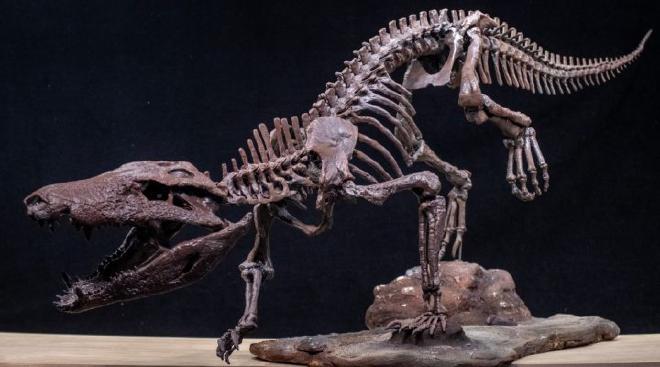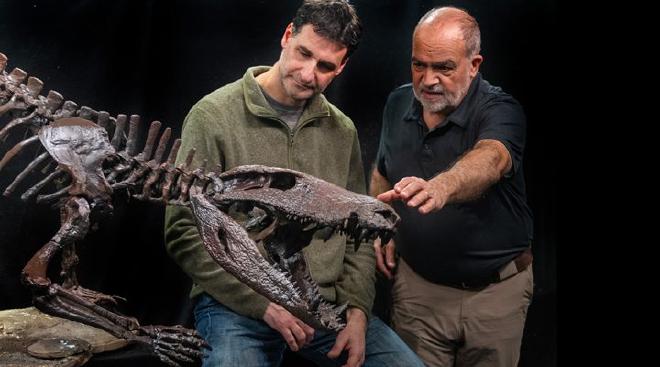

An interdisciplinary team of specialists from CONICET discovered a large part of the skeleton, including the skull and jaws, of a large crocodile that lived in southern Argentina 70 million years ago, in rocks from the Chorrillo Formation. The site of the discovery, described in the scientific journal PLoS ONE, is located about 30 km south of the town of El Calafate, in the southwest of the province of Santa Cruz. The researchers named the new animal Kostensuchus atrox, which means “fierce crocodile referring to the south wind.”

“This new species is distinguished from all previously known species by characteristics such as the large size of its teeth and skull, the robustness of its jaw, and the large size of the cavities where the muscles responsible for the bite were located. These characteristics are what lead us to interpret it as a top predator of the ecosystem,” comments Diego Pol, a researcher at CONICET in the Argentine Museum of Natural Sciences “Bernardino Rivadavia” (MACN-CONICET).
The head of Kostensuchus measured 50 centimeters long, being proportionally large compared to the rest of the body, becoming the “bulldog” of crocodiles. The snout was armed with more than 50 teeth, some of which were over 5 centimeters tall. The edges of the teeth are serrated, which increased the cutting ability of the flesh of its victims. The jaws were powered by powerful muscles that gave it a quick and extremely strong bite.
These anatomical features were key to interpreting the ecological role of Kostensuchus as one of the main predators of the late Cretaceous in Patagonia. “Another of the predators we have discovered in these rocks is the dinosaur Maip macrothorax (a carnivorous predator that was one of the last dinosaurs before extinction), a close relative of the Megaraptor from Neuquén. It is very likely that Kostensuchus and Maip competed for food, similar to the confrontations that occur today in Africa between hyenas and lions” says paleontologist Fernando Novas, researcher at CONICET in the Félix de Azara Foundation for Natural History and first author of the paper.
The finding #
Since 2019, this Patagonian region has been the subject of explorations led by Novas and his colleague Makoto Manabe from the National Museum of Tokyo, Japan, and their respective workgroups. “From the very first moment, we were able to appreciate the vast fossil potential that this area of our country has. The rocks that contain the fossils are called the Chorrillo Formation, and their age is around 70 million years,” Novas clarifies.
The dinosaurs discovered there include the great predator Maip macrothorax, and the herbivores Nullotitan glaciaris, nearly 25 meters long, and Isasicursor santacrucensis, the size of a guanaco. Now a robust crocodile, nearly 3 meters long, is added to the list of reptiles, and its powerful jaws indicate that it could confront a Maip as well as capture some of the contemporary herbivorous dinosaurs.


Then, during the coronavirus pandemic, Isasi dedicated almost six months of intense work. “With the help of high-precision pneumatic hammers, I was exposing the bone, and as the teeth began to appear, I couldn’t believe it: they were very large and shiny, and had serrated edges. My curiosity about what kind of animal was trapped in the rock was overwhelming, so the workday stretched from early in the morning until the early hours of the next day. I couldn’t stop working,” Isasi recalls. Once the pandemic was over, and after the bones were freed from the rock, the researchers were surprised to find that it was a new species of crocodile measuring just over three meters long, and that its skull and jaws were almost completely preserved.
It should be noted that the study of Kostensuchus also involved Makoto Manabe and Takanobu Tsuijishi from Japan and Ismar de Sousa Carvalho from Brazil, a specialist in Mesozoic crocodiles. Additionally, to conduct the research, the scientists received funding from the National Geographic organization, the Carlos Chagas Filho Foundation for Research Support of the State of Rio de Janeiro (FAPERJ), and the National Council for Scientific and Technological Development (CNPq) of Brazil."
Citation #
- The paper A new large hypercarnivorous crocodyliform from the Maastrichtian of Southern Patagonia, Argentina was published in PLoS ONE. Authors: Fernando E. Novas, Diego Pol, Federico L. Agnolín, Ismar de Souza Carvalho, Makoto Manabe, Takanobu Tsuihiji, Sebastián Rozadilla, Gabriel L. Lio & Marcelo P. Isasi.
A new large hypercarnivorous crocodyliform from the Maastrichtian of Southern Patagonia, Argentina Fernando E. Novas,Diego Pol ,Federico L. Agnolín,Ismar de Souza Carvalho,Makoto Manabe,Takanobu Tsuihiji,Sebastián Rozadilla,Gabriel L. Lio,Marcelo P. Isasi Published: August 27, 2025 https://doi.org/10.1371/journal.pone.0328561
- The article Descubren un nuevo cocodrilo que convivió con los últimos dinosaurios was published in CONICET’s website
Contact [Notaspampeanas](mailto: notaspampeanas@gmail.com)

